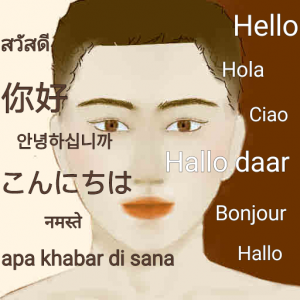BASTARDA continues to build their dynamic and explosive legacy on “Tamoj”
Laura Makabresku
Album cover of BASTARDA’s latest album “Tamoj,” where a headless girl stands at the intersection of bleak snow and somber fields, defining features of eastern Europe.
October 12, 2022
When’s the last time you listened to a foreign language album? For most people it might be years, or maybe never.
Foreign albums, simply due to the language barrier, are often seen as inaccessible. The reality is that music is a language, and the language of music matters to people. But most of us don’t just listen to music for its lyrics, its sound, hell even its quality. Sometimes we are simply creatures of comfort. So if you’re looking for an album with a sound, world and atmosphere that you can fall into effortlessly and magically, look no further than “Tamoj,” an album whose only cardinal sin is that it happens to be in a language other than English.
Released on Aug. 4, 2022, “Tamoj” comes as a collaboration between BASTARDA and Sutari. BASTARDA is a three-piece chamber modern classical group from Poland, and has churned out albums year after year over the last half decade, prominently featuring artists of different languages to sing for their albums, gaining underground notoriety. Sutari, like many of BASTARDA’s vocal collaborators, is relatively unknown, mainly making appearances as a traditional Polish folk group on the albums of other artists.
But it perhaps is the intrinsic relationship Sutari and BASTARDA hold to each other bound by their cultural upbringing as Poles. Birthed from this awareness and connection culturally, there is a truthfulness and depth to the sound of “Tamoj” that is unlike any of BASTARDA’s previous albums.
Thematically, the album describes itself as a blending of Belarusian and Polish sounds and culture, and it is the personal nature of the sound of this LP that allows it to communicate so well despite the language barrier. Throughout the record, there is a diverse palate of languages and an intersection of cultural identities throughout individual tracks. As a matter of meta-analysis, it’s a fascinating look into Europe’s own struggles with multiculturalism, a seemingly American concept of racial diversity and “cultural melting pots” being explored on this album.
However I’ll be honest in saying that most people aren’t looking to this album as a revolutionary treatise on multiculturalism or any of its thematic threads. The truth is that I can’t speak Polish, and I never plan to speak Polish. What draws me to this album is its incredible sonic textures, something entirely unique to this album that I’ve never heard before. It fundamentally acts as a fascinating exploration of the timbre of wind instruments for both BASTARDA and listeners, creating landscapes of sound unlike anything heard before from BASTARDA or most other chamber musicians.
On tracks like “Skuduciai,” the phrasing of Sutari’s vocals mimic the fluttery, poppy sounds of the flutes and short bowed strings, taking along the timbre of such instruments to create a seamless experience. When paired with the cold and isolated drones and chords, a feeling of walking through a desolate forest in the dead of winter, packed with snow searching for civilization, is created. The continued layering of vocals similar to a hymnal chorus allows for a gradual development and building of tension throughout the song while maintaining such phrasing of vocals as well, and these overall feelings of disorientation and continued wandering suggest to listeners the album’s overall themes of ambiguity and cultural indistinction.
Other tracks like “Tam nad puszczaj” bubble with life and movement, an upward sense of motion built into the repetition and arpeggiated and staccato strings, reminding listeners of the more upbeat parts of BASTARDA’s previous record “Fado,” and even more so of a San Salvador track.
What is so uniting of this album, though, is the amount of understanding it seems to hold within itself. It never seeks to rush its movements or push its instrumentation in a detrimental manner. Instead, it lets them build and crawl to the finish line, developing strong and sustained climaxes through stochastic and shepherds-tone-like invisible sensibilities.
As a matter of mixing as well, this album is far and away one of the most interestingly produced chamber music records of the last decade. Each instrument plays clearly as an internal melody and creates a sense of constant flow.
The balance, like most chamber music, tends to skew towards high directionality in the listening experience with only main vocals usually being centered, but typically to BASTARDA’s benefit. The centered vocals pitter pattering in and out of the ears continuously makes for an indulgent listen, one constantly engaged with the intimate performances.
This intimacy, characteristic of most chamber music and especially BASTARDA’s previous work, distinguishes itself on “Tamoj” primarily through its dynamic uses of drones and limited solos rather than constant full-frontal mixing.
The uniquely bright, inordinately thick, metallic pulses of Sutari’s voices on “Granic / Pasienio / Hranicia,” for example, pulses in and out of the instrumentation.
This creation of a baseline through their rhythms for the chaotic, disorganized overlapping solos of the other instruments feeds to listeners a startling and eye-catching point of reference for their ears in the otherwise dark, gravelly timbres of the baritone sax and cello. Such a dynamic use of vocals allows BASTARDA to trade hands instrumentally between themselves and Sutari effortlessly, and makes the most of their limited repertoire within the chamber music environment.
As a matter of thematics, the greyscale coloring of the entire album and its cover art speaks volumes to the cultural ambiguity in favor of more fluid understandings of community. This initially shows up in the sharply contrasting but constantly shifting tones of its instrumentation, and then later in the organization of the tracklist. Tracks often move from bright, piercing sounds to muddy, grimy sounds internally, and shift from broad strokes of color to desolate plains of isolated, cold sound from one track to the next.
And within this atmosphere, it’s sometimes hard to remember one is even listening to a foreign language album. This album’s strength and thematic core is its ability to dissolve into thin air, find itself in the back of your brain without even noticing, marrying itself to the hollow of your mind without care or understanding of how it is so powerful.
The language of this music may not be a language most people in America understand, but “Tamoj” reveals to listeners that music itself is a universal language through its strengths and motivations.
So if you’re looking to listen to more foreign language music, or just looking to listen to a wonderfully immersive, cohesive album that has the capacity to transport you to the far reaches of the world without stopping your doom-scroll down your phone, take a chance with “Tamoj.” You just might like it, even if you don’t understand a lick of Polish.




